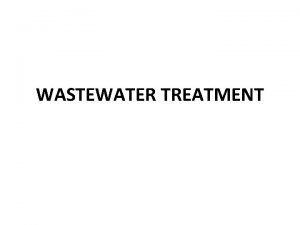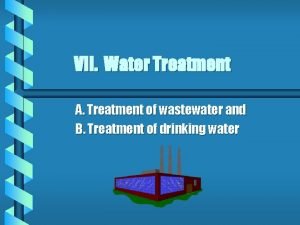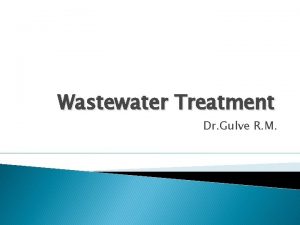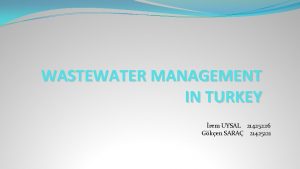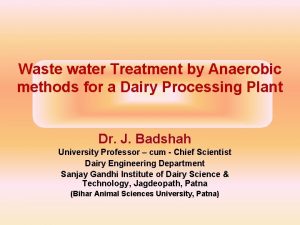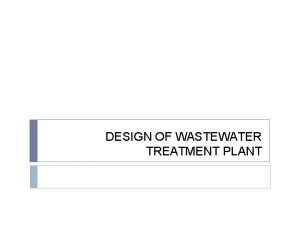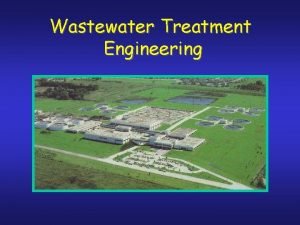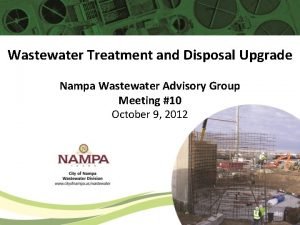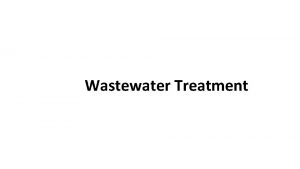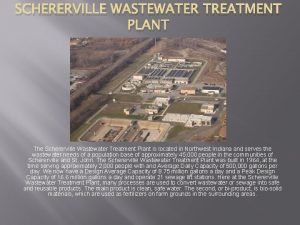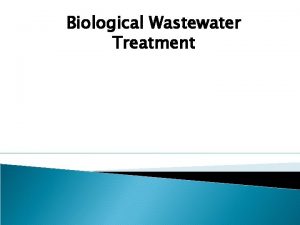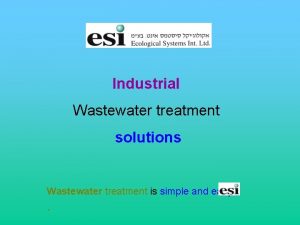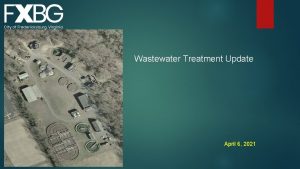Waste treatment WASTEWATER Chapter 22 l Sewer Sanitary












- Slides: 12

Waste treatment

WASTEWATER (Chapter 22) l Sewer – Sanitary waste l Generated from buildings – Liquid discharged from plumbing fixtures l Carried by sanitary sewer – Storm water l l Consists of rainwater, surface water, condensates, cooling water. Carried by storm sewer

Municipal sewage treatment Sedimentation l Aeration l Chlorination l Dechlorination l

Septic tank systems l Construction of septic systems – Septic tank l l Provides primary treatment of waste through sedimentation Aerobic decomposition of sediments – Aerobic bacteria survives in the presence of oxygen – Seepage pit l Provides secondary treatment of waste through leaching or filtration – Drainfield l l Provides secondary treatment of waste through leaching or filtration Percolation test

Sizing of septic tank Sized according to the number of bedrooms in residences l According to the total number of fixtures for nonresidential uses l Sizing is also determined by the soil condition l Once the capacity of the tank is determined in terms of gallons, it can be converted into cubic feet ( 1 cubic foot = 7. 48 gallons) l

Sizing a seepage pit l l l l Sized by determining the required leaching area Leaching area is the pit surface (wall area of the pit) required for seepage of effluent from the septic tank Wall area of a circular pit = * diameter of the pit * depth of the pit Assume an office building with 20 employees Daily sewage from the building = 20*20 = 400 gallons Minimum surface area required for seepage (assuming sandy loam soil condition): 40 sq. ft. /100 gallons Required pit surface for 400 gallons = 400*40/100 = 160 sq. ft. Assuming the diameter of the pit to be 6 ft. , depth of the pit = 160/( *6) = 8. 5 ft.




Sizing a drainfield l l l l Sized by determining the required leaching area Leaching area of a rectangular drainfield trench per lineal foot of its length = (1/2*Depth of the trench)*2 + Width of the trench Assume an office building with 20 employees Daily sewage from the building = 20*20 = 400 gallons Minimum surface area required for seepage (assuming sandy loam soil condition): 40 sq. ft. /100 gallons Required pit surface for 400 gallons = 400*40/100 = 160 sq. ft. Leaching area per foot of a drainfield (when trench section is 2’*2’ = (1/2*2)*2 + 2 = 4 sq. ft. Total trench length = 160/4 = 40 ft.

Sizing a drainfield l l l Minimum number of trench lines required = 3 Length of each trench line = 40/3 = 13. 33 ft. Maintain an o/c distance of 6 ft. between the trenches Provide at least 5 ft. on all sides Size of drainfield = (5+6*2+5)*(5+13. 33+5) = 513. 26 (say, 515 sq. ft. )

Lagoons, storm water l Percolation test – – – – l Lagoons – – l Determines the absorption capacity of soil Digging of holes, 4” dia 14” deep 2” of course sand or gravel placed at bottom Filling the holes with water, keeping it for at least 4 hrs. Filled with 6 inches of water after the above soaking Drop in water level measured every 10 minutes for one hour Rate measured as drop in inches per minute Shallow ponds Aerobic decomposition of waste Relatively impervious sides and floors Seven-day retention Storm water – – Separate pipes for carrying storm water Cross-connection with sanitary sewer to be avoided
 Purpose of wastewater treatment
Purpose of wastewater treatment Aquaculture wastewater treatment system
Aquaculture wastewater treatment system Wastewater treatment process primary secondary tertiary
Wastewater treatment process primary secondary tertiary Ashbridges bay wastewater treatment plant
Ashbridges bay wastewater treatment plant Municipal wastewater treatment
Municipal wastewater treatment Agricultural wastewater treatment technologies
Agricultural wastewater treatment technologies Anaerobic wastewater treatment
Anaerobic wastewater treatment Sacramento regional wastewater treatment plant
Sacramento regional wastewater treatment plant Agricultural wastewater treatment technologies
Agricultural wastewater treatment technologies Primary detention
Primary detention Secondary wastewater treatment
Secondary wastewater treatment Nampa wastewater treatment plant
Nampa wastewater treatment plant Wastewater treatment for dairy industry
Wastewater treatment for dairy industry

